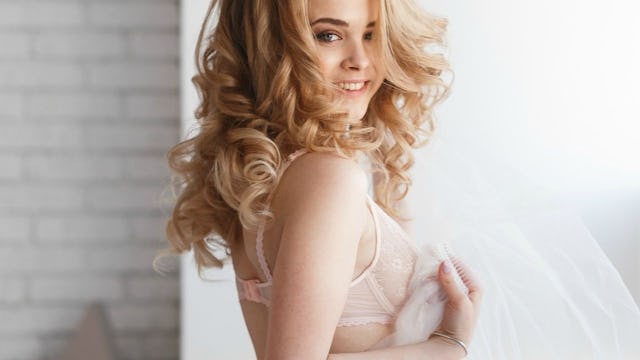Lingerie Shopping Is Awful, And Here's Why

“Lingerie shopping is too hard,” I messaged my husband during a three-week spell apart. There I was, on my computer looking at pictures of half-naked women, praying no one walked in and asked me what I was doing.
I imagined myself dressed like them in tight fitting leather garments. But somehow I knew I would never look like that. My hair didn’t cascade over my shoulders. My breasts would never seductively overflow from a corset — I’d been breastfeeding over a year and had visible droopage. How could anyone want to see me, a new mom, dressed that way?, I thought to myself. I guess I’m not sexy enough for lingerie.
My body has changed.
I felt confident and proud of my post-baby progress until I compared myself to the images on my screen. My expectation was to find an outfit that made me feel sexy and empowered. My goal was to walk into a room, take my husband’s breath away, and remind him why he chose me. But each time I got the courage to look for lingerie, I ended up feeling worse than when I started.
I wanted to feel like a “hot wife” for the first time in forever, but browsing the outfits left me feeling discouraged and underwhelmed. As I continued to scroll from top to bottom of page after page on site after site, I felt progressively worse. There was no shortage of outfits, but the women all looked the same — a level of same that made me feel inadequate. Huge cosmetically altered breasts, long slim legs, and more often than not, white skin. I couldn’t imagine any of the outfits looking good on me because none of the models shared my body type.
None of the women look like me.
It was almost like the “Are you 18+” message should have been followed up by “Are you sexy enough to fit into these clothes.” At least then I would have known there was no place for people like me in the world of lingerie. I wish I could say my search improved with time but it didn’t get much better. It reflected industry-wide issues that marginalize all of us who are “other.”
While efforts to increase diversity are on the rise in the fashion world, recent data from New York Fashion week still reflects lots of homogeneity. Only 27.9 percent of castings had models of color, 0.43 percent of models were “plus-sized” (aka, a size 8 in the fashion industry), and a mere 0.29 percent of models were over 50. The trends in the fashion industry set the tone for the models through the beauty industry — and they are letting the majority of us down.
I’m in the margins in more ways than one. I’m a natural-haired Black woman who finds herself surrounded by images of fair skin and long, flowing tresses. But it’s much more than that. Less than two years ago, I gave birth, so I have a slight pudge and stretch marks. Bringing my son into the world affected my stomach but also changed my breasts. I’ve sacrificially used my breasts to feed a baby for the last year and a half, so I don’t have the perky full boobs I did in the past. My cup size varies from day to day and finding a good bra is challenging. I’m only 5’3″, so my legs aren’t long and luxurious like the women who can be seen in the catalogs.
We’re headed in the right direction.
Fortunately, I married a man who doesn’t discourage me and finds the beauty in my new form. But I haven’t been as accepting of myself as he has. Knowing that outfits won’t look even mildly similar on me as they do on the models is disheartening. The process of lingerie shopping reminds me I don’t fit into society’s image of beauty.
Typically, I force myself to look past my negative feelings and purchase something anyway. It’s an act of resistance to remind myself that I deserve to be represented. Millions of women shared my sentiment and organizations are working to fill certain aspects of the need for diversity, like NAJA and their “Nude for All” collection. Sadly, these efforts have done little for body diversity — even their underwear models are thin, mostly white or light skinned, and have very loose curls or straight hair. There is no one-size-fits-all solution, so, despite tone diversity, my body type still isn’t represented.
The lack of diversity in lingerie is so much more than a race issue — it’s about size, unrealistic body goals, and the homogeneity of the market. As with everything, those of us at the intersections of those areas suffer the most.
But we have a long way to go.
Progress is being made — like ASOS swimsuit ad that showcases models untouched with visible stretch marks — but each of these women fit into the long thin criteria exalted by the modeling industry. Women of all sizes have stretch marks, but full-figured women are much more likely to be criticized for showing them.
The worst part is, many have less representation that I do — plus-sized women, women with disabilities, and many other women are nearly invisible. Not being represented in fashion leaves many of us feeling like we need permission to be sexy.
All women deserve representation in fashion and beauty. Until we fix the “diversity problem” things that are meant to make us feel empowered and beautiful will evoke feelings of shame.
I don’t have all the answers yet, but I’ve identified the problem, and it feels good to understand it’s not me finally.
Someone has to create a space for those of us whose beauty falls along the margins. Who knows, maybe that someone to create a line someone is me.
This article was originally published on